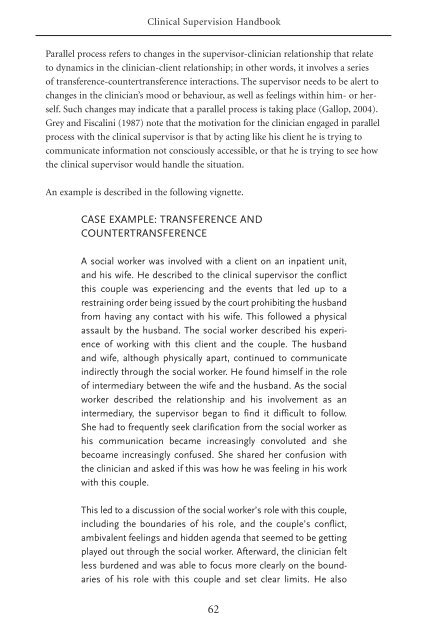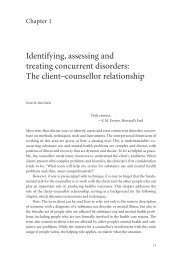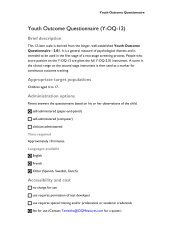Clinical Supervision Handbook - CAMH Knowledge Exchange ...
Clinical Supervision Handbook - CAMH Knowledge Exchange ...
Clinical Supervision Handbook - CAMH Knowledge Exchange ...
You also want an ePaper? Increase the reach of your titles
YUMPU automatically turns print PDFs into web optimized ePapers that Google loves.
<strong>Clinical</strong> <strong>Supervision</strong> <strong>Handbook</strong><br />
Parallel process refers to changes in the supervisor-clinician relationship that relate<br />
to dynamics in the clinician-client relationship; in other words, it involves a series<br />
of transference-countertransference interactions. The supervisor needs to be alert to<br />
changes in the clinician’s mood or behaviour, as well as feelings within him- or herself.<br />
Such changes may indicate that a parallel process is taking place (Gallop, 2004).<br />
Grey and Fiscalini (1987) note that the motivation for the clinician engaged in parallel<br />
process with the clinical supervisor is that by acting like his client he is trying to<br />
communicate information not consciously accessible, or that he is trying to see how<br />
the clinical supervisor would handle the situation.<br />
An example is described in the following vignette.<br />
CASE EXAMPLE: TRANSFERENCE AND<br />
COUNTERTRANSFERENCE<br />
A social worker was involved with a client on an inpatient unit,<br />
and his wife. He described to the clinical supervisor the conflict<br />
this couple was experiencing and the events that led up to a<br />
restraining order being issued by the court prohibiting the husband<br />
from having any contact with his wife. This followed a physical<br />
assault by the husband. The social worker described his experience<br />
of working with this client and the couple. The husband<br />
and wife, although physically apart, continued to communicate<br />
indirectly through the social worker. He found himself in the role<br />
of intermediary between the wife and the husband. As the social<br />
worker described the relationship and his involvement as an<br />
intermediary, the supervisor began to find it difficult to follow.<br />
She had to frequently seek clarification from the social worker as<br />
his communication became increasingly convoluted and she<br />
becoame increasingly confused. She shared her confusion with<br />
the clinician and asked if this was how he was feeling in his work<br />
with this couple.<br />
This led to a discussion of the social worker’s role with this couple,<br />
including the boundaries of his role, and the couple’s conflict,<br />
ambivalent feelings and hidden agenda that seemed to be getting<br />
played out through the social worker. Afterward, the clinician felt<br />
less burdened and was able to focus more clearly on the boundaries<br />
of his role with this couple and set clear limits. He also<br />
62

















